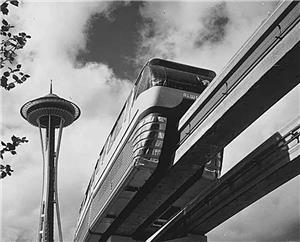On May 31, 2004, 150 passengers are evacuated when a fire halts the Seattle Monorail's “blue train.” The train, one of two four-car Alweg trains built for the 1962 Seattle World’s Fair, caught fire with 150 people aboard shortly after 5:20 p.m. as it departed from the Seattle Center Terminal. The train slowed to a stop on a banked curve just outside of the tunnel formed by the Experience Music Project (EMP) building on 5th Avenue. Witnesses said flames shot out six to eight feet from the rear of the train.
The south-bound monorail was carrying passengers away from the last day of the Northwest Folklife Festival, an event which drew approximately 125,000 visitors during Memorial Day weekend at the Seattle Center. As the fire started, passengers reported hearing a loud pop, the lights went out, and smoke began filling the train. The driver told the frightened passengers to move towards the front of the car, and shortly thereafter, the train’s doors opened. As the fire department arrived at 5:27 p.m., black smoke billowed out of the train down 5th Avenue.
Passengers gathered by the open doors, trying to get some fresh air before being rescued. Fire fighters hoisted a ladder to an open door at the front of the train, and began evacuating passengers, and a driver from Seattle Monorail Services parked the red train alongside the blue train and began evacuating passengers onto it via metal planks connecting the two trains. The monorail was designed to be able to evacuate passengers from one train to another in emergencies.
Evacuation
Most passengers escaped via the fire truck ladders positioned at doors of both trains, climbing down about 25 feet to the street, and about 50 passengers rode the red train back to the Seattle Center Terminal. Forty people were treated at the scene and released, and eight passengers plus one firefighter were taken to Harborview Medical Center to be treated for smoke inhalation. The firefighter had also injured a knee in the rescue. Passengers suffered no serious injuries, and none were burned. The eight passengers taken to the hospital were treated and released the same day.
“It was one of those times when your life flashes before your eyes. I was afraid we wouldn’t make it,” said Inna Brayman, 19, of Mercer Island, a passenger on the train. “People were panicked, but everyone was pretty civil and willing to help each other,” said Kerry Krugh, a visitor from Toledo, Ohio, who was on the train with his wife and two young sons. Ashley Best, 18, of Mukilteo, said “You couldn’t see 10 feet in front of you. People were crying. It was stressful. It was hard to breathe. My throat burned a lot” (Heckman).
Cause of the Fire
Seattle Monorail Services, a private company that manages, operates, and maintains the Alweg Monorail system under a profit-sharing contract with the City, hired an independent team to investigate the fire. Engineering consultants SNC-Lavalin, of Vancouver, Canada, and Hughes Associates, Inc., of Baltimore, Maryland, issued a report in July on how the fire happened. They concluded that the blue train’s third car suffered a broken low-speed drive shaft, speeding up the high-speed shaft, which also snapped. A piece of the high-speed shaft broke off and damaged the collector shoe that captures the positive electrical current from the rail. The collector shoe began to short-circuit and melted an aluminum housing, causing electric current to arc between the two rails, which were no longer insulated from each other (McGann). Sparks ignited grease and oil on the train’s undercarriage, then flames entered between the cars and ignited seat cushions (they were not original but dated from a 1990s car refurbishment). This caused the circuit breakers to blow, and the train stopped and began to fill with smoke from the fire (Barney).
After the fire, monorail service was suspended to permit a complete investigation of both trains to check whether the circumstances that led to this fire were part of a system-wide vulnerability. The red train re-entered service at 1:30 p.m. on the afternoon of December 16, 2004. Mayor Greg Nickels (b. 1955) and a Santa Claus conducted a short ceremony at the Seattle Center Monorail station to celebrate its re-opening. The blue train was repaired and re-entered service on May 2, 2005 (Barney).
Recommendations
The SNC-Lavalin and Hughes report recommended that the Monorail’s electrical systems be modified so that the car body and the structure of the train are isolated from the negative power rail (the negative power rail was bonded to the train car), that a “hot body” detection system be installed, and that a new grounding system be installed in the trains for when they are in the stations. These measures would keep the same sort of arcing-fire from happening again. A separate review of train materials for their fire-rating, and a fire-safety analysis in conjunction with the Seattle Fire Department were also suggested.
This was the first train fire in the 42-year history of the Monorail, which operates on an elevated 1.2-mile track from the Seattle Center to Westlake Center. It serves about two million passengers per year.

